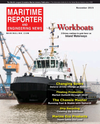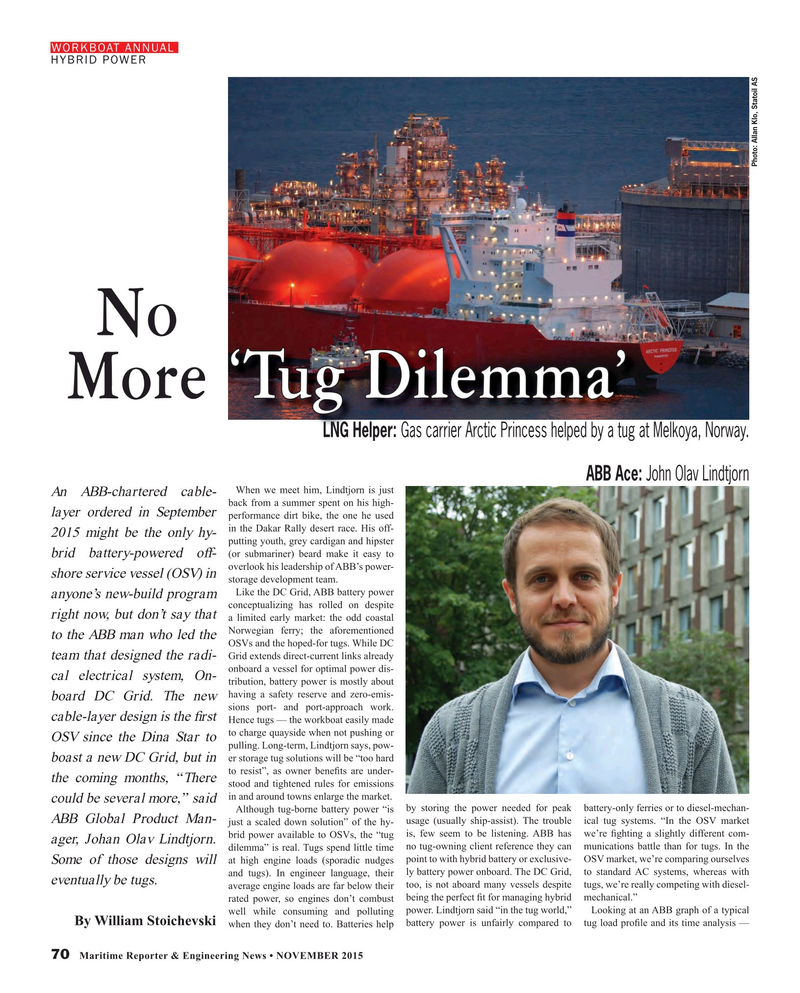
Page 70: of Maritime Reporter Magazine (November 2015)
Workboat Edition
Read this page in Pdf, Flash or Html5 edition of November 2015 Maritime Reporter Magazine
WORKBOAT ANNUAL
HYBRID POWER
Photo: Allan Klo, Statoil AS
No
More ‘Tug Dilemma’
LNG Helper: Gas carrier Arctic Princess helped by a tug at Melkoya, Norway.
ABB Ace: John Olav Lindtjorn
When we meet him, Lindtjorn is just
An ABB-chartered cable- back from a summer spent on his high- layer ordered in September performance dirt bike, the one he used in the Dakar Rally desert race. His off- 2015 might be the only hy- putting youth, grey cardigan and hipster (or submariner) beard make it easy to brid battery-powered off- overlook his leadership of ABB’s power- shore service vessel (OSV) in storage development team.
Like the DC Grid, ABB battery power anyone’s new-build program conceptualizing has rolled on despite right now, but don’t say that a limited early market: the odd coastal
Norwegian ferry; the aforementioned to the ABB man who led the
OSVs and the hoped-for tugs. While DC
Grid extends direct-current links already team that designed the radi- onboard a vessel for optimal power dis- cal electrical system, On- tribution, battery power is mostly about having a safety reserve and zero-emis- board DC Grid. The new sions port- and port-approach work. cable-layer design is the ? rst
Hence tugs — the workboat easily made to charge quayside when not pushing or
OSV since the Dina Star to pulling. Long-term, Lindtjorn says, pow- er storage tug solutions will be “too hard boast a new DC Grid, but in to resist”, as owner bene? ts are under- the coming months, “There stood and tightened rules for emissions in and around towns enlarge the market. could be several more,” said
Although tug-borne battery power “is by storing the power needed for peak battery-only ferries or to diesel-mechan-
ABB Global Product Man- usage (usually ship-assist). The trouble ical tug systems. “In the OSV market just a scaled down solution” of the hy- brid power available to OSVs, the “tug is, few seem to be listening. ABB has we’re ? ghting a slightly different com- ager, Johan Olav Lindtjorn. dilemma” is real. Tugs spend little time no tug-owning client reference they can munications battle than for tugs. In the at high engine loads (sporadic nudges point to with hybrid battery or exclusive- OSV market, we’re comparing ourselves
Some of those designs will and tugs). In engineer language, their ly battery power onboard. The DC Grid, to standard AC systems, whereas with eventually be tugs.
average engine loads are far below their too, is not aboard many vessels despite tugs, we’re really competing with diesel- rated power, so engines don’t combust being the perfect ? t for managing hybrid mechanical.” well while consuming and polluting power. Lindtjorn said “in the tug world,” Looking at an ABB graph of a typical
By William Stoichevski when they don’t need to. Batteries help battery power is unfairly compared to tug load pro? le and its time analysis — 70 Maritime Reporter & Engineering News • NOVEMBER 2015
MR #11 (66-73).indd 70 11/2/2015 11:49:04 AM

 69
69

 71
71
